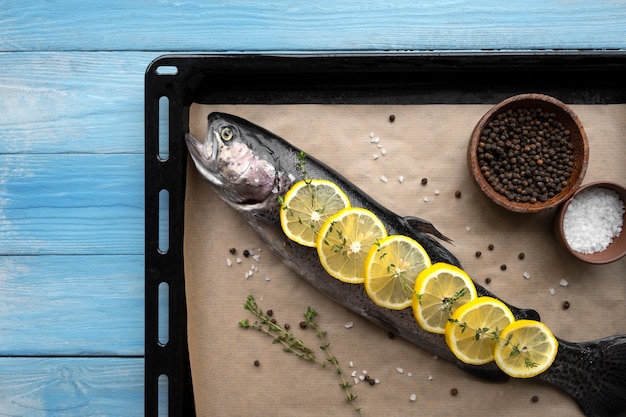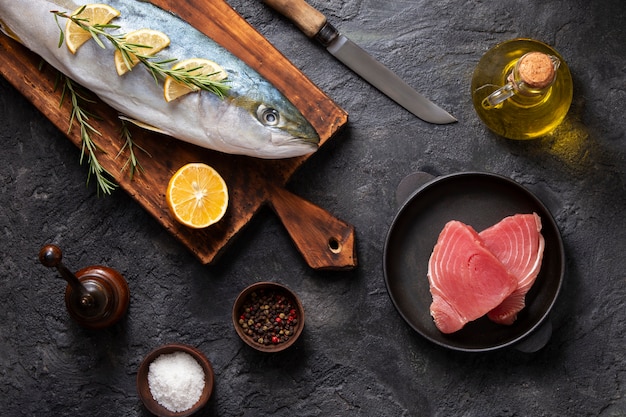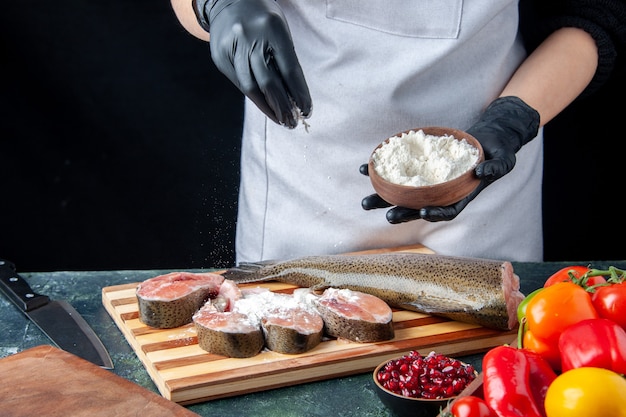Let me tell you, folks, there’s something truly magical about halibut. It’s not just a fish; it’s a culinary experience. That firm, flaky texture, the delicate, slightly sweet flavour – it’s a symphony of taste! But let's be real, sometimes figuring out how to cook this prized catch can feel like a puzzle.
Well, fret no more! I'm diving deep into the world of halibut, sharing my secrets, my go-to recipes, and all the insider tips I’ve picked up over the years. We'll explore the best ways to cook this fish, from simple pan-frying to elegant roasting. We'll even delve into some creative twists and turns, because let's face it, halibut can be so much more than just the usual suspects.
Buckle up, grab your aprons, and get ready to experience halibut in a whole new light!
(Part 1) The Halibut: A Look Inside

Choosing the Right Halibut
You know how some people say, "you can't judge a book by its cover?" Well, you can't judge halibut by its size or colour. The key is to look for a few telltale signs of freshness.
First off, firmness. A good halibut fillet should be plump, not flabby. Press your finger gently on the surface; it should bounce back quickly.
Moisture is another important sign. The fillet should feel moist, but not slimy. If you notice a slimy surface, steer clear – it's likely not fresh.
Finally, smell. A fresh halibut has a clean, slightly sweet scent, maybe even a hint of the ocean. If you pick up a strong fishy smell, it's a red flag. It's probably not as fresh as you'd like.
Speaking of red flags, avoid any fillets with dark spots or discoloration. That's a sure sign it's gone past its prime.
And remember, don't be shy about asking your fishmonger for advice. They're the experts, and they'll be happy to help you pick out the perfect piece for your recipe.
Types of Halibut Cuts
Halibut comes in different shapes and sizes, and each cut is suited to a particular cooking method.
Fillets: These are the most common cut, and they're a real workhorse. They're usually boneless and skinless, making them easy to cook. Fillets are perfect for pan-frying, grilling, or baking.
Steaks: These thicker cuts are ideal for grilling or baking. They often have a bone running through the centre, so remember to remove that before cooking. Steaks are great for a hearty meal and hold up well to high heat.
Loin: Imagine the crown jewel of the halibut – that's the loin. This boneless and skinless cut comes from the top part of the fish. Loins are known for their delicate flavour and tender texture. They're perfect for pan-frying, grilling, or even poaching.
Halibut Nuggets: These smaller, bite-sized pieces are perfect for frying or baking. They're a fun and easy way to introduce halibut to kids, or to make a quick and easy snack.
Storing Your Halibut
Fresh halibut is a precious commodity, so treat it with care. Wrap your fillets or steaks tightly in plastic wrap or store them in an airtight container. Keep them in the refrigerator for up to two days, but not longer.
If you're planning to use your halibut later, freezing is a great option. Wrap the fillets tightly in plastic wrap and then place them in a freezer-safe bag. Frozen halibut can last for up to three months.
Halibut: A nutritional powerhouse
Now, let’s talk about the good stuff – the health benefits of this wonderful fish. Halibut is a nutritional superstar, packed with essential nutrients that support your well-being.
Protein: Halibut is an excellent source of lean protein, which is crucial for building and repairing muscle tissue. It’s a powerhouse for growth and development.
Omega-3 Fatty Acids: These healthy fats are like little superheroes for your body. They promote heart health, improve brain function, and help reduce inflammation.
Vitamin D: Halibut is a good source of vitamin D, which is vital for strong bones and a healthy immune system. It helps your body absorb calcium and phosphorus, essential minerals for bone health.
Selenium: This mineral is an antioxidant, protecting your cells from damage caused by free radicals.
Potassium: Potassium is important for maintaining healthy blood pressure and proper muscle function.
(Part 2) cooking techniques: From Simple to Spectacular

Pan-Frying for a Crisp Finish
Pan-frying is a quick and easy way to cook halibut, and it's one of my favourite methods. The intense heat creates a beautiful, crispy crust while keeping the inside tender and juicy. Here’s how to pan-fry like a pro:
1. Pat your halibut dry: This ensures that it crisps up nicely. Use paper towels to gently pat the surface.
2. Heat your pan: A cast iron pan is perfect, but any sturdy skillet that can handle high heat will do.
3. Add oil: Use a high-heat oil, such as grapeseed or olive oil. A small amount is all you need.
4. Season your halibut: Salt and pepper are the classic pairing, but feel free to experiment with herbs and spices. Try a blend of herbs like thyme, rosemary, and oregano for a Mediterranean twist.
5. Cook until golden brown: Depending on the thickness of your halibut, you’ll need to cook for 3-5 minutes per side.
6. Check for doneness: Use a fork to gently pierce the thickest part of the fish. If it flakes easily, it’s cooked through. You can also use a meat thermometer to check the internal temperature. It should reach 145°F (63°C).
Roasting for a Tender Interior
Roasting is the perfect way to bring out the delicate flavour of halibut and create a beautiful, moist fish. It's a bit more hands-off than pan-frying but just as delicious. Here's how to achieve roasting perfection:
1. Preheat your oven: Set your oven to 400°F (200°C).
2. Prepare your halibut: Season generously with salt, pepper, and any other herbs or spices you like. A sprinkle of paprika or a little chili powder can add a delightful kick.
3. Place on a baking sheet: Line your baking sheet with parchment paper for easy cleanup.
4. Roast for 10-15 minutes: Cook until the fish is flaky and opaque. Keep an eye on it towards the end of cooking, as ovens can vary.
5. Rest: Allow your halibut to rest for a few minutes before serving. This allows the juices to redistribute, ensuring a moist and tender finish.
Grilling for a Smoky Flavour
Grilling halibut adds a delightful smoky flavour and creates those beautiful grill marks. It's perfect for a summer barbecue or any outdoor meal. Here's how to grill like a pro:
1. Preheat your grill: Heat your grill to medium-high heat.
2. Season your halibut: Season generously with salt, pepper, and any other desired spices. Try a citrusy blend of lemon zest, garlic, and herbs for a vibrant flavour.
3. Grill for 4-6 minutes per side: Cook until the fish is flaky and opaque. Don't forget to flip the halibut only once to ensure a beautiful sear on each side.
4. Rest: Allow your halibut to rest for a few minutes before serving.
Baking for a Simple and Easy Meal
Baking halibut is a fantastic option for a quick and easy meal. It’s a no-fuss method that delivers a tender and moist fish every time. Here’s what you need to do:
1. Preheat your oven: Set your oven to 375°F (190°C).
2. Prepare your halibut: Season generously with salt, pepper, and any other desired spices. A simple sprinkle of lemon pepper is always a delicious choice.
3. Place on a baking sheet: Line your baking sheet with parchment paper for easy cleanup.
4. Bake for 15-20 minutes: Cook until the fish is flaky and opaque. Check for doneness with a fork, making sure the halibut flakes easily.
5. Rest: Allow your halibut to rest for a few minutes before serving.
(Part 3) Delicious Halibut Recipes: A Taste of Variety

Simple Pan-Seared Halibut with Lemon and Herbs
This recipe is a timeless classic, and for good reason. It’s simple, flavourful, and perfect for any occasion.
Ingredients:
1 lb (450g) halibut fillets, skin removed
1 tablespoon olive oil
1 tablespoon butter
1/2 lemon, sliced
1 tablespoon chopped fresh parsley
1/2 teaspoon salt
1/4 teaspoon black pepper
Instructions:
1. Pat the halibut fillets dry with paper towels.
2. Heat the olive oil and butter in a large skillet over medium-high heat.
3. Season the halibut with salt and pepper.
4. Place the fillets in the skillet and cook for 3-4 minutes per side, or until golden brown and cooked through.
5. Transfer the fillets to a serving platter.
6. Squeeze the juice of the lemon over the halibut.
7. Sprinkle with the chopped parsley.
8. Serve immediately.
Baked Halibut with Garlic and Herbs
This recipe is a true crowd-pleaser. The combination of garlic and herbs is simply irresistible.
Ingredients:
1 lb (450g) halibut fillets, skin removed
2 tablespoons olive oil
2 cloves garlic, minced
1/4 cup chopped fresh parsley
1/4 teaspoon salt
1/4 teaspoon black pepper
Instructions:
1. Preheat your oven to 375°F (190°C).
2. Place the halibut fillets in a baking dish.
3. In a small bowl, combine the olive oil, garlic, parsley, salt, and pepper.
4. Pour the mixture over the halibut fillets.
5. Bake for 15-20 minutes, or until the halibut is cooked through.
6. Serve immediately.
Grilled Halibut with Mango Salsa
This dish is a summery explosion of flavour, perfect for a barbecue or a light lunch.
Ingredients:
1 lb (450g) halibut fillets, skin removed
1 ripe mango, diced
1/2 red onion, diced
1/4 cup chopped fresh cilantro
2 tablespoons lime juice
1 tablespoon olive oil
1/4 teaspoon salt
1/4 teaspoon black pepper
Instructions:
1. Preheat your grill to medium-high heat.
2. Combine the mango, red onion, cilantro, lime juice, olive oil, salt, and pepper in a bowl.
3. Season the halibut fillets with salt and pepper.
4. Grill the halibut fillets for 4-6 minutes per side, or until cooked through.
5. Serve the grilled halibut topped with the mango salsa.
Halibut with Lemon-Dill Sauce
This dish is a classic pairing that never fails to impress. The lemon and dill create a bright and refreshing flavour that complements the halibut perfectly.
Ingredients:
1 lb (450g) halibut fillets, skin removed
1 tablespoon olive oil
1/2 lemon, juiced
1/4 cup chopped fresh dill
1/4 cup mayonnaise
1 tablespoon Dijon mustard
1/4 teaspoon salt
1/4 teaspoon black pepper
Instructions:
1. Preheat your oven to 375°F (190°C).
2. Place the halibut fillets in a baking dish.
3. In a small bowl, combine the olive oil, lemon juice, dill, mayonnaise, Dijon mustard, salt, and pepper.
4. Pour the mixture over the halibut fillets.
5. Bake for 15-20 minutes, or until the halibut is cooked through.
6. Serve immediately.
(Part 4) Beyond the Basics: Unlocking Culinary Creativity
Playing with Flavours
Halibut is a blank canvas, ready to be painted with a symphony of flavours. Experiment with different herbs, spices, and sauces to create your own culinary masterpieces.
Mediterranean Magic: Embrace the sun-kissed flavours of the Mediterranean with a blend of oregano, thyme, and garlic.
Spicy Kick: Add a touch of heat with chili flakes, paprika, or a splash of ginger.
Sweet Symphony: Embrace a touch of sweetness with a drizzle of honey or maple syrup.
Beyond the Plate: Thinking Outside the Box
Don't be afraid to think outside the box and experiment with different ways to use halibut.
Halibut Tacos: Flaky halibut pairs beautifully with fresh toppings like avocado, cilantro, and lime.
Halibut Chowder: A hearty and comforting soup that’s perfect for a chilly day.
Halibut Pasta Primavera: A light and flavorful dish with seasonal vegetables.
Halibut for Every Occasion
Halibut is a versatile fish that can be enjoyed for any occasion. It's perfect for a casual weeknight dinner or a special celebratory meal.
Casual Weeknight Dinner: Pan-fried halibut with lemon and herbs is a simple and delicious option.
Special Occasion Meal: Roasted halibut with garlic and herbs is a sophisticated and impressive dish.
Summer Barbecue: Grilled halibut with mango salsa is a refreshing and flavorful option.
Family Feast: Baked halibut with lemon-dill sauce is a crowd-pleasing choice.
(Part 5) Serving Up Your Halibut Masterpieces
The Importance of Presentation
Don't underestimate the power of presentation! A beautifully plated dish can elevate your halibut from good to great.
Choose the right plates: Select a plate that complements the colour and texture of your halibut. A simple white plate or a plate with a subtle design will allow the flavours to take centre stage.
Arrange your ingredients: Create a visually appealing arrangement of your halibut, vegetables, and sauce. A dash of colour can really enhance the overall presentation.
Add a touch of garnish: A sprig of fresh herbs or a squeeze of lemon can add a touch of elegance and freshness to your dish.
Accompanying Dishes
Halibut pairs well with a variety of side dishes, depending on your taste and the recipe you choose.
Vegetables: roasted asparagus, sauteed spinach, or a simple green salad are all excellent choices.
Potatoes: mashed potatoes, roasted potatoes, or potato gratin are classic pairings for halibut.
Rice: A simple white rice or a more flavorful brown rice can complement your dish.
Pasta: A light pasta dish, such as spaghetti with a tomato sauce, can be a tasty pairing.
(Part 6) FAQs: Your Halibut Questions Answered
Q1: How do I tell if halibut is cooked through?
A: Halibut is cooked through when it’s flaky and opaque, and the internal temperature reaches 145°F (63°C). You can check for doneness with a fork or a meat thermometer. If the halibut flakes easily when you pierce it with a fork, it’s cooked through.
Q2: Can I freeze halibut?
A: Yes, you can freeze halibut for up to three months. Wrap it tightly in plastic wrap or place it in an airtight container. Thaw it in the refrigerator before cooking. Freezing halibut doesn't affect its quality as long as you follow proper storage procedures.
Q3: What is the best way to cook halibut?
A: The best way to cook halibut depends on your preference and the recipe you’re making. Pan-frying, roasting, grilling, and baking are all excellent methods. Each method brings out a different aspect of the halibut’s flavour and texture.
Q4: What are some good substitutions for halibut?
A: If you can’t find halibut, you can substitute it with cod, mahi-mahi, or swordfish. These fish share similar textures and flavours, making them suitable replacements in many recipes.
Q5: What are some tips for cooking halibut?
A:
Don’t overcook it: Halibut is a delicate fish that can easily become dry if overcooked. Keep a close eye on the cooking time, and don’t overcook it.
Season generously: Halibut has a mild flavour, so don’t be afraid to season it generously. Experiment with different herbs, spices, and sauces to find your perfect combination.
Let it rest: Allow your cooked halibut to rest for a few minutes before serving to allow the juices to redistribute. This will ensure a moist and tender fish.
(Part 7) Halibut: A Culinary Treasure
Halibut is a truly special fish that deserves a place in your culinary repertoire. It’s versatile, flavorful, and a healthy choice. With its firm texture and delicate flavour, it's a true culinary treasure.
As you explore different cooking methods and recipes, you’ll discover the endless possibilities of this magnificent fish. Embrace the joy of cooking with halibut and delight your taste buds with its unique and delicious flavour.
(Part 8) A Final Word: From My Kitchen to Yours
I hope this guide has inspired you to embrace the world of halibut. Cooking this magnificent fish can be a truly rewarding experience, and I encourage you to experiment, explore, and discover your own favourite halibut recipes.
Remember, the key to cooking halibut is to keep it simple and let the natural flavour shine through. So, have fun, be creative, and enjoy!
Everyone is watching

Corn on the Cob: The Ultimate Guide to Perfectly Cooked Ears
Healthy MealsAh, corn on the cob. Just the name evokes images of sunny days, barbecues, and that sweet, juicy flavour that ...

Perfect Pork Roast Oven Cooking Time: A Guide to Delicious Results
Healthy MealsThere's something truly satisfying about a perfectly roasted pork. The aroma alone is enough to make your mout...

Ham Cooking Time: How Long to Bake, Smoke, or Boil a Delicious Ham
Healthy MealsAh, ham. It's a classic, isn't it? A real crowd-pleaser, especially around holidays. And when done right, it'...

Scallops: The Ultimate Guide to Perfect Cooking
Healthy MealsAh, scallops. Those delicate, sweet, and utterly delicious morsels of the sea. They hold a special place in my...

Spaghetti Squash: The Ultimate Guide to Cooking and Serving
Healthy MealsRemember that time you saw spaghetti squash at the supermarket, looking all bumpy and strange, and thought, "W...
